Partida Rol por web
Justice in Sabbath
4. [ACT1-Sc4] The Cattle Drive
- Portada
- Announcements / Latest News / Questions
- Saloon [Off-topic]
- 0. [Pre-Production] Cattle Thieves
- 0. [Pre-Production] The Mormon Businessman
- 0. [Prologue] Welcome to the West
- 1. [ACT1-Scene1] Saddle Up
- 2. [ACT1-Scene2] The Outlaws
- 3. [ACT1-Scene3] San Acoma
- 4. [ACT1-Sc4] The Cattle Drive
- 5. [ACT1-Sc5] Guns for Hire!
- 6. [ACT1-Sc6] Fun Night Out in Bannock
- 7. [AC1-Sc7] The Hunter
- 8. [ACT1-Sc8] Ride into Sabbath
- 9. [Act1-Sc9] A Bed too Big
- 10. [ACT1-END] End of Act I
- 11. [ACT2-Sc11] He Carried the Law
- 12. [ACT2-Sc12] First Meeting at the Bronson Ranch
- 13. [ACT2-Sc13] Day for Choosing
- 14. [ACT2-Sc14] The World Turning Beneath Your Feet
- 15. [ACT 2-Sc15] Laura´s Room
- 16. [ACT2-Sc16] Who´s Got the Edge
- 17. [ACT2-Sc17] Business in Town
- 18. [ACT2-Sc18] El Alacran
- 19. [ACT2-Sc19] The Predators
- 20. [ACT2-Sc20] Old Fort Gunfight
- 21. [ACT2-Sc21] Vigilante Justice
- 22. [ACT2-Sc22] Trinity
- 23. [ACT2-Sc23] At the Price Farm
- 24. [ACT2-Sc24] Hour of the Gun
- 25. [ACT2-Sc25] When the Dead Are Buried
- 26. [ACT2-Sc26] High Stakes
- 27. [ACT2-END] End of Act II
- 28. [ACT3-Sc28] Resolution
- 29. [ACT3-Sc29] Epilogue
- [Additional Content] Guide to the West
- Boothill
- Aces&Eights-Tutorials
- The Poker Room
- Shooting Range
- Goods & Services
- Err ... What?
- Casting
- Musical Score
- Behind the Scenes (VIP)
- Director´s Corner
Sinta and Crowe got the left flank moving. The cattle formed a herd with its leaders and specific movements, and once it picked up momentum, it was simply a question of steering them in the right direction. The roundup started exceptionally well, bearing in mind the size of the herd. Lon and Razor took over the herding on the left flank with the animals perfectly organized and in formation.
However, on the other side, Brimley and Corman were having huge difficulties with the cattle. It seemed they were faced with some very stubborn ones, and did not manage to get them to move. To make matters worse, the two Jenkins brothers rode to help, shouting and yelling, and the cattle reacted going on the opposite direction.
- Tiradas (3)
Motivo: Lon-herding
Tirada: 1d100
Dificultad: 67+
Resultado: 95(+40)=135 (Exito)
Motivo: Razor-herding
Tirada: 1d100
Dificultad: 41+
Resultado: 51(+40)=91 (Exito)
Motivo: Brimley-Corman-Jenkins(2)
Tirada: 4d100
Resultado: 17, 46, 56, 80 (Suma: 199)
Notas de juego
Crowe: the difficulty on the roll is your skill level, for Sinta it is 76% (now 64% and for you 53%)
Razor stopped his horse and looked back on his saddle. The most important rule on a cattle drive was never to scare the cattle, and the Jenkins brother were acting recklessly. Now several hundred heads were between him and the strayed animals.
He made a gesture with his gloved right hand to his stetson sombrero, and looked right and then at Sinta and Crowe who were riding behind.
-Go give´em a hand, would ya?, he whispered.
- Sure thing, man!
Sinta pulls the reins of her mare to make her turn. The animal had become her friend already and followed her commands without hesitation.
- Crowe, you coming?
Having said that, he very gently kicked the mare with her heels and made her gallop towards those incompetents with half a brain. She burned inside. She really wanted to show that Corman that a woman could move the herd as well, if not better, than any stupid man.
Notas de juego
I am not sure if I have to roll Herding again or do something else before. I am happy if the Director wants to roll the dice.
The plan is: Sinta will move to the other side of the herd as soon as possible, will make her best to control the herd, and (if successful) will make a witty but not too unfriendly remark to Corman (something like "You see, Corman, women are good for one thing: herding cattle. Now I wonder what you are good for. Maybe offering an apology? The days in front of us are too long to be on bad terms so soon").
Sinta kicked her horse and went to help to herd the animals on the other flank. She worked with precision, and Crowe also joined in and between the two of them, all the animals were gathered together.
Brimley and Corman took over the herding, with the animals moving in the right direction. -See, Jenkins. That´s how it´s done, Corman said nodding at Sinta and Crowe. -Watch and learn.
It was easy from there on, and Crowe and Sinta could relax and ride in the back to make sure all the cattle arrived safely.
- Tiradas (3)
Motivo: herding-Sinta
Tirada: 1d100
Dificultad: 64+
Resultado: 67(+20)=87 (Exito)
Motivo: herding-Crowe
Tirada: 1d100
Dificultad: 53+
Resultado: 12 (Fracaso)
Motivo: Brimley-Corman
Tirada: 2d100
Resultado: 28, 37 (Suma: 65)
Vern looked at the cowboys. He had noticed what had been going on, and how Sinta had dealt with the situation. He saw Sinta make some sort of a remark to Corman, but the redneck did not reply. Once on the drive, there was no room for silly arguments and contests. He did not expect everyone to be best of friends, but a true cowboy would get the job done no matter what. No excuses. Hopefully these two got their things sorted. But if not, it should not get in the way of their work either.
-Jenkins, you two are going to ride the drag, he said to the two youngsters. The drag was the place for the most inexperienced of cowboys, trailing the cattle. Still, this was going to be a great learning experience for them.
As the rest of the cowboys passed by, he gave them their functions for the start of the cattle drive. Vernon was the Trail Boss, and directly behind him, on either side, were the Right and Left Point. These key positions would be for Joe Brimley and Razor. The right side was to be as follows: Joe Brimley as point, Corman as swing and Hurd as Right Flank. On the opposite side, Razor would be the Left Point, Sinta the Left Swing and Crowe the Left Flank.
Lon would take care of scouting, and Conrad Howler of the horses. The chucwagon was also ready to go, driven by Dave Hitchins. Finally, Jason Bronson had decided to join the ride.
-Gentlemen! Tomorrow before sunset, we ride, Adams said with a satisfied smile on his face.
Sinta said nothing. Another day, another dollar. Kinda.
Now it was time for dinner, a bit of chit-chat, and hopefully a good sleep. Corman had not replied anything but she knew that in the future he would think twice about making remarks questioning her value again. That was good enough.
Now it was the time to be friends, as far as possible, especially with Corman, Brimley, and Razor. The good think about mature men is that they could see they were wrong even if they never for the hell of it would say it loud. Hopefully Corman would be like that. Sinta made a note to show herself friendly at dinner time, to show that there were no hard feelings.
The trail was going to be hard enough as it was.
The first cattle drives from Texas on the legendary Chisholm Trail headed north out of DeWitt County about 1866, crossing Central Texas toward the markets and railheads in Kansas. The trail was named for Indian trader Jesse Chisholm, who blazed a cattle trail in 1865 between the North Canadian and Arkansas rivers. That initial trail was expanded north and south by other drovers. The trail was not one fixed route. As one historian remarked, "trails originated wherever a herd was shaped up and ended wherever a market was found. A thousand minor trails fed the main routes."
Within a few years the railroad was built to Abilene, Kansas, and that town became a shipping point for cattle. The longhorns came north across the Red River, through what is now the Kiowa and Comanche reservations, then into Cheyenne and Arapaho country. They crossed the treacherous South and North Canadian Rivers, went on to the Cherokee Outlet and the Salt Flat, then 25 miles farther to the Kansas border and north to Abilene.
As new rails were laid, other towns such as Wichita and Dodge City replaced Abilene as the destination of the cattle drives. About 1880 the Santa Fe laid rails to Caldwell, Kansas, and soon it was a rip-roaring town. Cowboys from the trail herds got drunk, shot out the street lights, and rode into saloons ordering whiskey for themselves and their horses.
"About this time conditions changed rapidly, due to fencing and settlers taking up land for cultivation. The large ranchers moved farther West and the small rancher fenced his range. By the Panic of 1893, the open range virtually disappeared and cattle drives became a thing of the past!

The next day, many hours before the sunrise, the cowboys gathered together to start the cattle drive. Some of the cowboys had worked till late branding the stock after the roundup, even though most of that work was done by the Bronson ranch hands. Each head was counted, and there were 1500 in total ready to go.
Hitchins had made some coffee and breakfast, and each cowboy was given a tin mug, a spoon and a fork. On the other hand, they were all asked to leave their guns in the chuck wagon. Guns were really of little use in a cattle drive, except maybe when scouting or during guard duty at night. This was a logical decision--it would be rather difficult and possibly dangerous to cowboy, horse, and cattle, to try and maneuver through a herd with a rifle strapped to a saddle. If a cowboy wore a gun on a drive it was worn high up on the waist.
As for the cattle, most cattle drives were rounded up Texas Longhorns. Eventually, though, the customers back East grew tired of the tougher Longhorn meat. It was also discovered that Longhorns carried--but were immune to--a deadly cattle disease called the Texas Tick. Ranchers started adding shorthorns, Herefords, and Brahmans to their herds to provide a tastier choice of meat. These breeds also proved to be immune to Texas Tick.
The cowboys called all the cattle by the same names, though--critters, beeves, and doggies.
The Texas Longhorn was tough, cunning and mean. He was on his own from the minute he was born, and after living several years in the brush, he did not take kindly to being roped, hog-tied, road branded and thereafter held loose herded until the drive got underway.
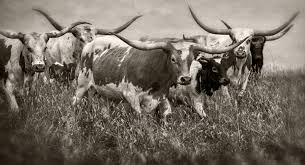
Sometimes, the cowboys would sing to the cattle on the drives, just as they did at night, calling out, "Get along little doggie," as they moved them down the dusty trail.
OK, guys, listen up, he said with a calm voice. Behind him, standing on the porch was Vincent Bronson, and next to him the foreman Steinbaugh. -After we have gathered the herd to be driven, we´re goin´ to make an early start this morning and drive the herd at a fast walking gait all day. This is to drive ´em hard the first day, so to get as far away from the home bedding ground as possible the first night. If a herd would be near their home ground when bedding time arrived, they´d give us considerable trouble by trying to drift back to their usual ground.
Conrad was the first to get moving, emptying his cup on the fire. He did not like coffee much, and he was eager to get going. He rode on his horse, and in no time came back with a huge remuda of nearly sixty horses. Each cowboy would need around four or five horses on the drive, and the horse wrangler was the person taking care of all the horses.
The youngest cowboy in the group was generally in charge of the remuda, which could be as large as 150 horses. Remuda comes from the Spanish word remonta, or remount. The cowboy in charge of the remuda was called the Wrangler and would follow along behind the cattle, keeping the horses in line. The word Wrangler, like so many cowboy terms, also came from a Spanish word, caballerango, or "one who cares for horses." Many cowboy terms came from the Spanish because the cowboy profession was started by the Spanish Vaqueros, Spanish and Native American Indians who were trained to watch over the cattle of Spanish Missionaries.
The Wrangler knew each horse by name and was expected to know immediately if a horse was missing and to track it down. His job was not easy--bandits and Indians often tried to steal horses from the remuda. Horse thieves were considered the lowest of the low and often shot on sight or strung up from the nearest tree. Shooting an unarmed man or shooting a man on the back, however, was against the Code of the West.
The wrangler herded the horses at night, bringing them into camp about sunup so the boys could rope their mounts for the day. Each rider was allotted four head besides his own horse. When the horses were turned in with the herd, the wrangler slept in the chuck wagon and helped the cook when we stopped for water and chuck.
Everything was ready, and Vernon Adams took the lead. This was his big chance, and he greeted Mr. Bronson from his horse by touching his Stetson with his right hand. Then he signaled for the rest to take their positions.
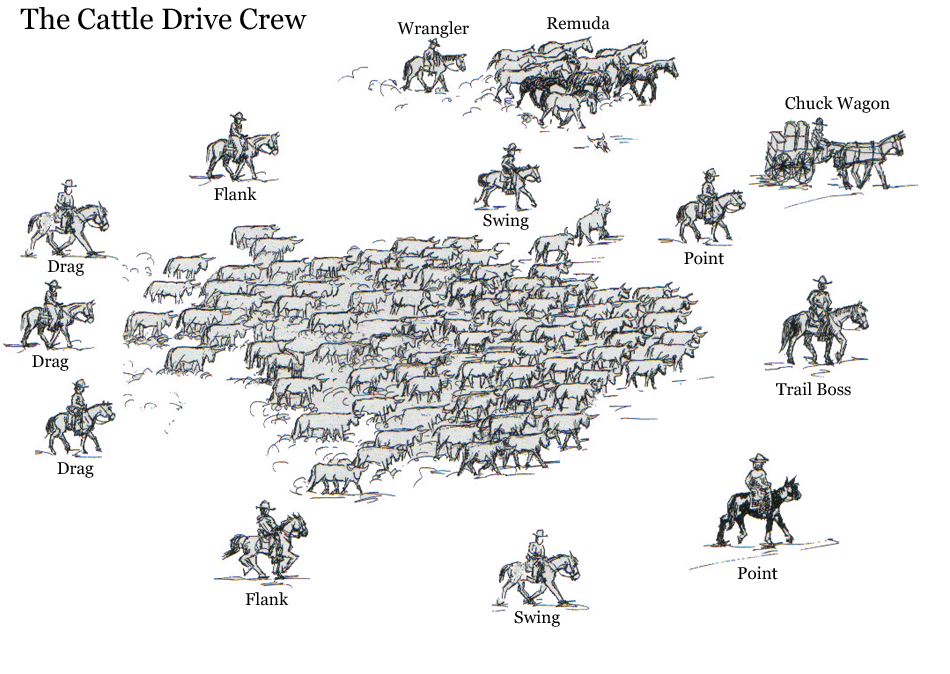
Razor and Brimley were riding the Point, and then the ranch hands opened the gates to allow the fifteen hundred animals to start moving forward. Initially it took quite a lot of yelling and pushing, but gradually they picked up the pace.
Once the cattle were moving down the trail, the trail boss took the lead. The column stretched behind him for half a mile. On the sides of the column rode the flank riders who were responsible for chasing down strays. The drag riders rode behind to keep the cattle moving forward.
The cattle did not move in a line, but more of a wedge. Oddly, they seemed to take the same position each day. They knew where they belonged. The more aggressive cattle moved to the front, while the young, weak, or lazy cattle hung behind.
- Tiradas (10)
Motivo: vern-husbandry
Tirada: 1d100
Dificultad: 30+
Resultado: 46 (Exito)
Motivo: vern-herding
Tirada: 1d100
Resultado: 62
Motivo: day1-encounter
Tirada: 3d10
Resultado: 1, 3, 8 (Suma: 12)
Motivo: day1-encounter2
Tirada: 3d10
Resultado: 10, 3, 5 (Suma: 18)
Motivo: day1-weather
Tirada: 1d100
Resultado: 97
Motivo: day2-enc
Tirada: 3d10
Resultado: 9, 6, 1 (Suma: 16)
Motivo: day3-enc
Tirada: 3d10
Resultado: 2, 10, 9 (Suma: 21)
Motivo: day2-weather
Tirada: 1d100
Resultado: 10
Motivo: day3-weather
Tirada: 1d100
Resultado: 48
Motivo: day1-2-3-water
Tirada: 3d100
Resultado: 7, 48, 25 (Suma: 80)
The first day the cowboys pushed the cattle forward at double the normal movement rate. It was important to get as far away as possible from the cattle´s usual grazing territory. On the other hand, it was not advisable to push the animals too hard for too many days as they could get tired. Also, the water and the food were to be taken into consideration. The quality of beef was the main concern always. Adequate drinking water was essential to the health of any herd. Beeves could drink up to 03 gallons of water a day. So each day without water could have terrible consequences.
On the very first day, there was a somewhat difficult situation with local farmers. As soon as they became of the heard, they insisted that it left the area. However, Jason and Vernon spoke to the farmers and used all the influence Mr. Bronson had in the region. Eventually, the farmers agreed to trade for beef, and Vernon ordered three cows to be given to them. In exchange, the farmers supplied the cowboys with a week of fresh food.
The cattle moved forward, and when they finally camped for the night, Vernon had a look around the animals. He had been taking care of them for many months, and the quality of beef was exceptional. He wanted to keep it that way. Therefore he had decided to head northeast, taking advantage of the green grass territories and then following the river towards Forth Worth.
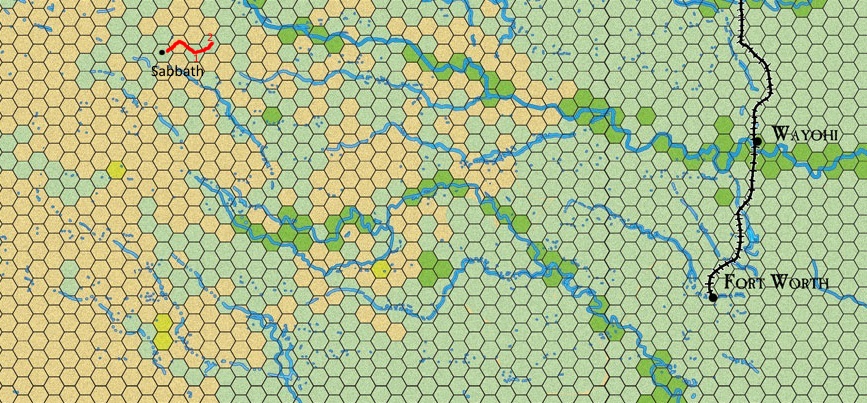
The second day was through adequate territory, with sufficient grass for the cattle. However, as the evening approached, dark clouds gather in the sky and a thunderstorm is upon them!! Vernon signals halt, and looks at the storm and lightning. The risk of stampede was upon them, and they needed to react quickly.
- Tiradas (2)
Motivo: salesmanship
Tirada: 1d100
Resultado: 33
Motivo: salesmanship-cattle
Tirada: 1d6
Resultado: 5
Notas de juego
Describe action and make Animal Herding roll with -10% modifier
The storm was upon them and the cattle was getting skittish. Not good. Sinta and her mare trotted up and down the herd talking on a low voice to calm the animals down.
"Wooow... wowowowow... Sssshhh... wooowowow..."
A couple of times she had to dismount and touch one or two of the cows that were especially nervous. She caressed them, she talked to them, they reacted to her touch, they calmed down...
Then it started to rain. Strong, tepid rain that soon soaked them all to the bone...
- Tiradas (1)
Motivo: Animal Herding: keep cattle calm in storm
Tirada: 1d100
Dificultad: 64+
Resultado: 99(-10)=89 (Exito)
Notas de juego
I think that´s a success. If not, could I use Animal Empathy to help in any way?
The cattle were nervous before the storm came. It was the cattle's instinct which enabled the animal to realize a storm was on its way and would want to drift to shelter. But the cowboys were hard at work trying to keep them together.
And then the heavens opened, and the rain was pouring down. Sinta was holding her flank together, riding up and down and trying to calm the animals down. Whenever thunder struck, she could hear. Thunder and lightning was the most common cause for a stampede, but they all knew what had to be done.
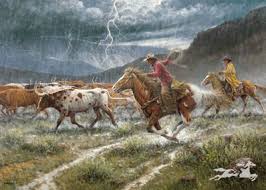
In the middle of the storm, you could hear the clashing of horns. Some of the leaders were nervous, and these could cause the herd to go wild. So it was a question of finding these leaders and concentrating on them.
Vernon Adams kept his cool and took care of the front of the herd, and signaled his points Brimley and Razor. Finally, the storm passed away, and all animals and cowboys were accounted for.
- Tiradas (12)
Motivo: herding-VA-Br-Co-Ra
Tirada: 4d100
Resultado: 83, 55, 41, 23 (Suma: 202)
Motivo: encounter-4
Tirada: 3d10
Resultado: 8, 1, 3 (Suma: 12)
Motivo: encounter-5
Tirada: 3d10
Resultado: 2, 10, 3 (Suma: 15)
Motivo: weather-4-5
Tirada: 2d100
Resultado: 23, 51 (Suma: 74)
Motivo: water-4-5
Tirada: 2d100
Resultado: 34, 84 (Suma: 118)
Motivo: encounter
Tirada: 1d4
Resultado: 1
Motivo: encounter-6
Tirada: 3d10
Resultado: 5, 5, 2 (Suma: 12)
Motivo: encounter-7
Tirada: 3d10
Resultado: 10, 10, 4 (Suma: 24)
Motivo: quality
Tirada: 1d20
Resultado: 14
Motivo: water 6
Tirada: 1d100
Resultado: 56
Motivo: weather-6-7
Tirada: 2d100
Resultado: 30, 25 (Suma: 55)
Motivo: herding
Tirada: 1d100
Resultado: 9
Notas de juego
Animal Empathy could help to identify the leaders, or nervous animals. It is not required now as the Animal Herding was a very high roll and success, but in the future it can be used before Animal Herding to make the roll easier.
The long hours were starting to take its toll on the cowboys. As they camped for the night, there were very few jokes as they all hit the sack exhausted. The first few nights, Corman had played the flute, but now he also wanted to get his sleep. At least the fresh food from the farmers was good.
On the fifth day, the cattle drive entered a dry and bare territory. The storm had been a blessing of sorts, but now the water could become an issue. Lon had not found any, and the cattle could dehydrate in a few days. But Vernon was confident they would get to a stream by the next night.
As they prepared to continue the cattle drive the following morning, they noticed a dead and half-eaten cow towards the end of the herd, about twenty yards away from the rest.
Lon went quickly to have a look, and came back with some bad news. –Looks like a pack of wolves. Best to keep going and leave this area behind, or they will kill some more.
The next day went also without any source of water, and the effects of dehydration started showing up on the animals. Also, more and more horn flies started attacking the animals. These bloodsuckers were about half the size of house flies, and of dark gray color. They stayed on the shoulders and backs of cattle almost continuously, and the quality of the beef was getting worse by the hour. It was more and more difficult to control the herd. Finally, they entered a lush territory and could see a river in the distance.
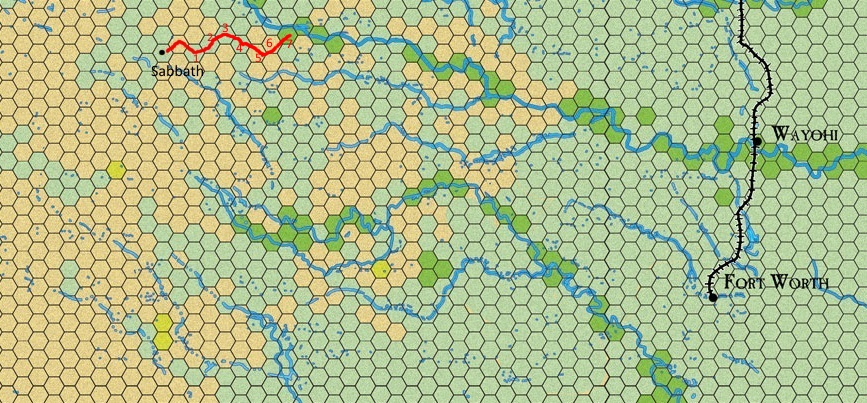



![[Br] Ryan [Br] Ryan](/imgs/rpw/pnjs/5362af7455b36.png)



![[Br] Conrad Howler [Br] Conrad Howler](/imgs/rpw/pnjs/54d291f704e15.png)
